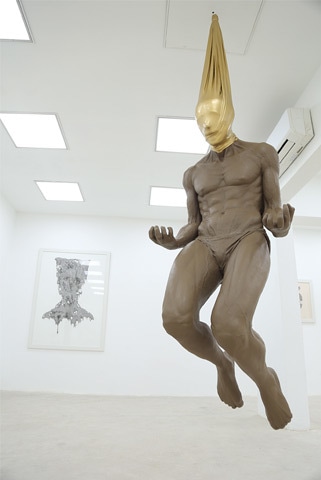Walking into Saud Baloch’s solo show ‘Under the Dust’ at Sanat Gallery is an overwhelming experience visually, emotionally and even intellectually once you get down to dissecting it against a global context. The show, curated by Madeline Amelia Clements, features sculptures ranging from life-size and life-like, to miniature rock formations, along with large scale intricate pen drawings of a decaying human form. Together, they present a haunting look at a humanitarian crisis that a devastating 2016 can well and truly relate to.
‘Under the Dust’, or Tah-e-Khaak in Urdu, alludes to Habib Jalib’s poem, “Tum se pahle vo jo ik shakhs yahan takht-nashin tha,
Us ko bhi apne khuda hone pe itna hi yaqin tha … aj soye hain tah-e-khaak na jaane yahan kitne”.
Dedicated to the lives lost in the recent tragedy in Quetta, Saud Baloch’s exhibition ‘Under the Dust’ has a way of getting under your skin
“The one before you who graced this throne, Also believed himself an infallible god ... Who knows how many of them sleep under the dust here today.”
The work is a crude reminder of the inevitability of death, and the fragility of life and all that we depend on for survival — our homes, our wealth, our possessions, and even our relationships with other human beings. It is perhaps our arrogance that transforms these affiliations into a source of pride and entitlement, but Baloch unveils them as a source of burden, suffocation, restriction and even torture instead.
These unsettling images are not new to Baloch’s work. His previous series ‘Sustained’ and ‘Anomalous’ both dealt with similar themes, where lifelike figures were bent under heavy burdens or curled and twisted in despair. Here we see the burden taking a more specific connotation of wealth and luxury. These visuals emerge as a reaction towards the artist’s own surroundings and experiences as a resident of Nushki, Balochistan, a conflicted territory with its fair share of violence and bloodshed. He recently lost his own cousin in the Quetta blast, which makes his work even more relevant and close to home, and he decided to dedicate this show to him. As Baloch admits, however, such themes are easily applicable to the failure of our collective humanity on a global scale.
It is perhaps the love of wealth and possessions of those is power that becomes a source of burden and suffocation for the rest. In ‘Golden Age,’ a man hangs from the ceiling by a golden cloth, smothered and choked by wealth itself. In Badhshah we see a dejected boy skinned and deformed under a gleaming golden crown. It makes us think of the Balochi struggle to be compensated for the wealth of their land, being treated unfairly by those in power. On the other hand, the dependency and attachment to wealth and possessions is a universal phenomenon, giving us all a feeling of entitlement, which eventually becomes the source of our own oppression. It is where death, destruction and human hardship originate.

The realism in these pieces is indented with scratches, battered and abused. The effect is achieved through the use of the medium itself, almost as if the work was abandoned half way through, with clay slapped on without being sculpted or finessed. This is in contrast to the smaller pieces that have an organic randomness to their shape and form. The violent texture of the volcanic rock is fitting, as it is born through adversity and torture, much like the subjects of the sculpted pieces.
The drawings seem to mimic this texture, constructed through miniature circles strung together to create decaying fragments of the body. These seem to be hollow forms that might scatter at the touch of a finger, or blow away with a gust of wind. It is reminiscent of a piece of burnt wood in a fireplace that retains its shape until nudged, when it collapses into a pile of ash and soot. The bodies seem to be contorted into agony, wrapped and suffocated, the shadow of an eye within the skull-like shape scrunched with pain.
One can’t help but be enthralled by the sheer skill and technique of the sculptural pieces that lay bare the sinewy anatomy of the human body, right down to the rippling veins wrapping the muscle. The sculptures have been cast from clay in fiberglass and painted over to give the illusion of wet clay. To Baloch, clay is reminiscent of dirt and mud, which is the origin of human life, and possibly the final destination.
The gloom and despondency imbedded in these works touches an emotional chord within the viewer; ‘Under the Dust’ has a way of getting under your skin. The purpose here, however, is not to depress but to awaken our humanity and compassion. Baloch uses his power as an artist to aestheticise harsh realities and articulate certain aspects that otherwise go unnoticed. We are compelled to reflect on our own place in the scheme of things and mend our ways before we too return under the dust.
‘Under the Dust’ is on exhibition at the Sanat Initiative, Karachi from August 16th to 26th
Published in Dawn, Sunday Magazine, August 21st, 2016















































Dear visitor, the comments section is undergoing an overhaul and will return soon.